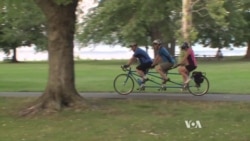Almost one in five Americans - some 43 million people - has a disability. But that does not have to keep them away from sports. Not only does participating in a sport provide rehabilitation, it promotes independence.
There are several organizations in the United States dedicated to getting everyone - amputees, people who are blind or deaf, those with brain injuries or medical issues - onto the ski slopes, basketball courts, rivers and riding trails.
Disabled athletes may start early, boosted by teams in their schools and communities, or like Bob Hartt, 62, return to a favorite passion of their youth.
Hartt hadn’t ridden a bike in 20 years, since losing his sight from a progressive eye disease. His wife Bonnie O’Day, 58, has been legally blind since childhood. But the two are avid cross-country skiers, going out with guides who provide orientation through verbal descriptions and instructions.
Three years ago, their guides suggested that the couple might want to try biking to keep in shape the rest of the year.
“I thought it would be a great opportunity to get back to doing something I used to love doing,” Hartt said.
So they bought a couple of used tandem bikes and began to recruit volunteers to ride with them. The couple lives near Washington, D.C., where cycling is popular.
“Once we put out the call, it was a matter of coordination as to who would captain or pilot the two-seaters,” O’Day said.
That grew into a club called “Tuesday Night Tandems,” which meets in a Northern Virginia neighborhood once or twice a week after work.
“We usually have four or five teams of riders,” Hartt added.
When there is an odd number of blind riders, Hartt and O’Day ride the 3.2-meter, three-seat tandem bike that volunteer Mark Mulligan carefully unloads from the roof of his car.
The riders soon take off down the driveway, picking up speed as they move downhill out of the neighborhood. They are careful to obey traffic lights and stop signs as they follow a network of trails that leads them along the Potomac River.
Tandem captain pilots, stokers fuel engine
In tandem language, Mulligan is team captain. His job is to make sure there are no surprises for the blind riders that sit behind him. They're called stokers.
“So you’re supposed to tell them what’s coming up, what’s going on. The difference is learning to actually describe what we’re doing," he said. "I call it the cruise director. You’re trying to describe the sights as we’re going on.”
Mulligan says it is a misconception that blind people don’t know where they are.
“When we go out on a new ride I have to announce landmarks and after repeating the same ride, it puts a map in their heads," he said. "I’ve seen Bob out with a new volunteer and he’s telling him where to go. Bonnie does the same thing.”
Hartt doesn’t want Mulligan to do more than his share.
“We want to keep up on our side of bargain by keeping in shape ourselves. We want to make it fun for them as well,” he said.
A well-choreographed dance
After dozens of tandem rides, the three work together like a well-oiled machine, acutely aware of one another and their surroundings. Hartt says the ride is like a choreographed dance.
“It just feels great when you’ve got some speed and you’re going around some curves, and you’re all in sync," he said. "Once you get going you get that breeze, you get a little wind chill and it cools you right off and it’s just a lot of fun.”
O’Day loves to be out in nature.
“It’s faster than walking, which is really good and as I go by things, I get to smell them," she said. "I get to experience the wind in my face and the smell of the flowers and a bakery if you happen to go by one, like the one we passed today.”
Nearly three hours later, the bikers head down the home stretch, tired, hungry but happy, like any cyclist who has just ridden 40 kilometers.
“We’re not unique in any way," O'Day pointed out. "There are a lot of blind people who ride tandems. And, of course, when we’re riding the people who are around us don’t know we’re vision-impaired. So, we’re just out there doing the regular thing just like everybody else and I think that’s good.”
The teams pull into the driveway where they started their ride. Hartt and O'Day dismount and give each other a hug, buoyed by a sense of confidence and camaraderie that they carry back into their daily lives.





